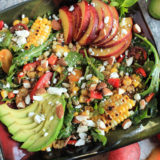Heirloom Cantaloupe Delight

Geri Wohl, CNC
Better Eating Coach
Written By: Geri Wohl, CNC
www.bettereatingcoach.com
We’ve all heard of cantaloupe and honeydew. But what are heirloom melons? These melons are a hybrid form of cantaloupe, crossing a European-style melon with an Eastern style melon. This heirloom variety is about 60 to 80 years old. The blend of the melons used is proprietary with the result being a firm flesh melon full of sweetness and flavor.
While the uniform netting around the exterior rind of the melon identifies most cantaloupes, heirloom cantaloupes have distinctive grooves running from one end of the melon to the other. The exterior ridging changes color from green to golden yellow as the fruit ripens. Typically, these hybrids are smaller than traditional cantaloupes, but their seed cavity is also smaller resulting in more juicy flesh.
Heirloom melons are low in calories. A quarter of a melon only yields about 50 calories so they are a great addition to the diet for those interested in weight loss. Being low in calories is due to its high water content, about 90%, making it a perfect summer treat that can help quench your thirst. Melons are easily digested with much of the digestive work occurring in the mouth via chewing and saliva.
With its sweetness comes sugar. Melons have a relatively high glycemic index at 65 but the glycemic load is low at 7.8. The glycemic index (GI) is a ranking to understand how quickly a carbohydrate will break down and raise one’s blood sugar levels. The higher the number on a scale of 0-100, the quicker the food breaks down into its simple sugar components. The glycemic load (GL) as defined by Wikipedia, on the other hand, “estimates the impact of carbohydrate consumption using the glycemic index while taking into account the amount of carbohydrate consumed. GL is a GI-weighted measure of carbohydrate content.” It also takes into account the fiber and other components that will mitigate the breakdown of sugars. So even though melon may appear to affect one’s blood sugar quickly, its GL is low making it a welcome addition to the summer diet. For more about blood sugar regulation, see my article, “The ABCs of Apples“.
These hybrid melons are also an excellent source of vitamins A and C, having 100% and 80% of the recommended daily value, respectively. They also contain fiber, folate and important antioxidants like beta-carotene and lycopene. They have no fat or cholesterol and are low in sodium. Vitamin A, a fat-soluble vitamin, is a powerful antioxidant that is known for supporting our vision and immune system and the health of our mucus membranes and skin.
Heirloom cantaloupes are rich in beta-carotene, a red-orange pigment that is an important antioxidant. The body readily converts beta-carotene into the more useable form of vitamin A needed. As an antioxidant, beta-carotene protects us from harmful free radicals that can cause various diseases and chronic conditions. Studies have shown that beta-carotene supports lowering one’s cardiovascular risk. In addition, if you consume at least 4 servings of beta-carotene-rich foods, there may be a lowered risk of developing certain cancers. Over 500 different carotenoids have been identified in the plant and algae world with beta-carotene being the most prevalent in the human body. It is best to obtain vitamin A from food sources to get the synergistic benefit of the multiple.
Vitamin C is a water-soluble vitamin that supports our immune system and works with vitamin A as another antioxidant. For more about the benefits we obtain from vitamin C, see my article, “Nectar of the Gods“.
 Picking a good melon can sometimes seem to be an exercise in luck. Here are some sensory cues to guide you into choosing a ripe and sweet fruit.
Picking a good melon can sometimes seem to be an exercise in luck. Here are some sensory cues to guide you into choosing a ripe and sweet fruit.
- Look: The exterior of the melon needs to be the right color. In the case of the heirloom melon, the ridgelines should be a creamy yellow. The coloring of the underlying rind should also appear more yellow and not green.
- Listen: Next, some people say to knock on the melon to see if it sounds hollow. Hollowness indicates ripeness. I like to shake a melon to see if I can hear any of the juices rattling around.
- Smell: From the stem end, there should be an aromatic aroma that you associate with melon.
- Feel: The rind should feel firm with a slight give. If is too hard, it will need to sit out and ripen more fully. If is too mushy, it is overripe and best to avoid purchasing it.
Heirloom melons can be stored uncut at room temperature if under-ripe. Once melon is ripe, store in refrigerator and eat within about four days.
Experience the nuances of these delicious summertime melons and enjoy!
© Geri Wohl, CNC











